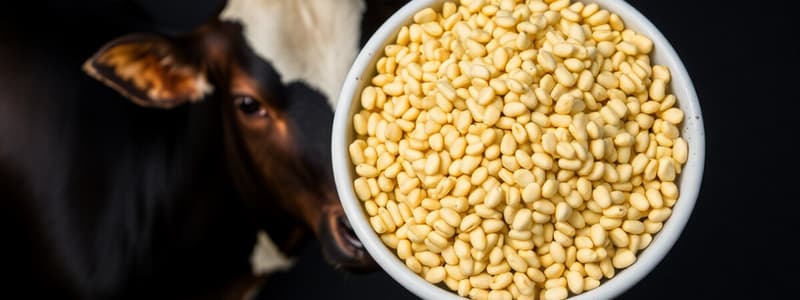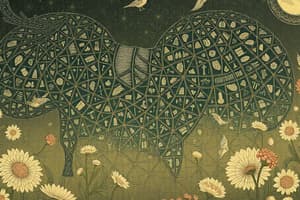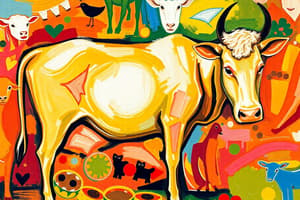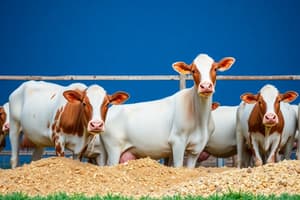Podcast
Questions and Answers
Feedstuffs with more than 18% crude fiber, such as pasture and hay, are classified as ______.
Feedstuffs with more than 18% crude fiber, such as pasture and hay, are classified as ______.
roughages
Ingredients like corn and barley are categorized as ______ feeds because they primarily provide calories.
Ingredients like corn and barley are categorized as ______ feeds because they primarily provide calories.
energy
Materials left over from processing plants and animals are known as ______ feeds.
Materials left over from processing plants and animals are known as ______ feeds.
by-product
Supplements that contain over 20% crude protein are classified as ______ supplements.
Supplements that contain over 20% crude protein are classified as ______ supplements.
Substances such as probiotics and enzymes that enhance feed efficiency or promote health are known as ______.
Substances such as probiotics and enzymes that enhance feed efficiency or promote health are known as ______.
[Blank] are high in crude fiber and essential for ruminant animals to maintain rumen function and prevent digestive disorders.
[Blank] are high in crude fiber and essential for ruminant animals to maintain rumen function and prevent digestive disorders.
[Blank] are low in crude fiber and high in energy and/or protein, making them suitable for supplementing diets.
[Blank] are low in crude fiber and high in energy and/or protein, making them suitable for supplementing diets.
Oilseed meals such as soybean meal and cottonseed meal are examples of ______.
Oilseed meals such as soybean meal and cottonseed meal are examples of ______.
Cereal grains like corn and barley are primary ______ sources in animal feeds.
Cereal grains like corn and barley are primary ______ sources in animal feeds.
[Blank] such as calcium and phosphorus are critical for bone development and overall metabolism in animals.
[Blank] such as calcium and phosphorus are critical for bone development and overall metabolism in animals.
Vitamins A, D, E, and K are classified as ______ vitamins and are essential for various physiological functions.
Vitamins A, D, E, and K are classified as ______ vitamins and are essential for various physiological functions.
[Blank] are non-nutritive substances added to diets to improve feed efficiency, growth, or health.
[Blank] are non-nutritive substances added to diets to improve feed efficiency, growth, or health.
[Blank] such as probiotics and enzymes, can improve gut health and nutrient absorption in animals.
[Blank] such as probiotics and enzymes, can improve gut health and nutrient absorption in animals.
Ensuring that feed is free of ______ and spoilage is essential for maintaining its nutritional value and safety for animal consumption.
Ensuring that feed is free of ______ and spoilage is essential for maintaining its nutritional value and safety for animal consumption.
Providing adequate ______ is often overlooked, but it is essential for nutrient transportation, temperature regulation, and metabolic reactions.
Providing adequate ______ is often overlooked, but it is essential for nutrient transportation, temperature regulation, and metabolic reactions.
Proper feed classification allows nutritionists to formulate balanced diets that meet the specific ______ of animals at different life stages.
Proper feed classification allows nutritionists to formulate balanced diets that meet the specific ______ of animals at different life stages.
[Blank] such as limestone and dicalcium phosphate, are essential for bone development and overall metabolism in animals.
[Blank] such as limestone and dicalcium phosphate, are essential for bone development and overall metabolism in animals.
[Blank] refers to native vegetation grazed by livestock in extensive grazing systems, providing them with essential nutrients and fiber.
[Blank] refers to native vegetation grazed by livestock in extensive grazing systems, providing them with essential nutrients and fiber.
Synthetic amino acids like ______ are added to improve protein quality.
Synthetic amino acids like ______ are added to improve protein quality.
The use of ______ as feed additives is restricted due to concerns about antimicrobial resistance.
The use of ______ as feed additives is restricted due to concerns about antimicrobial resistance.
Flashcards
Feedstuff Classification
Feedstuff Classification
Feeds categorized by source, nutrients, and purpose in animal diets.
Roughages
Roughages
Feeds high in fiber (over 18%), low in energy; examples include hay and pasture.
Concentrates
Concentrates
Feeds low in fiber (under 18%), high in energy/protein like grains and oil meals.
By-product feeds
By-product feeds
Signup and view all the flashcards
Energy Feeds
Energy Feeds
Signup and view all the flashcards
Protein Supplements
Protein Supplements
Signup and view all the flashcards
Mineral Supplements
Mineral Supplements
Signup and view all the flashcards
Vitamin Supplements
Vitamin Supplements
Signup and view all the flashcards
Feed Additives
Feed Additives
Signup and view all the flashcards
Pasture
Pasture
Signup and view all the flashcards
Hay
Hay
Signup and view all the flashcards
Silage
Silage
Signup and view all the flashcards
Cereal Grains
Cereal Grains
Signup and view all the flashcards
Oilseed Meals
Oilseed Meals
Signup and view all the flashcards
Calcium and Phosphorus
Calcium and Phosphorus
Signup and view all the flashcards
Probiotics
Probiotics
Signup and view all the flashcards
Enzymes (in feed)
Enzymes (in feed)
Signup and view all the flashcards
Study Notes
- Feedstuffs are classified based on their origin, nutrient composition, and use in animal feeding
- This classification helps in formulating balanced diets, understanding the nutritional value and optimizing animal performance and health
By Origin
- Roughages: High in fiber (over 18% crude fiber), low in energy; includes pasture, hay, silage, and straw
- Concentrates: Low in fiber (less than 18% crude fiber), high in energy and/or protein; includes grains, oil meals, and by-product feeds
- By-product feeds: Residual materials from industrial processing of plant and animal products
- Mineral Supplements: Sources of essential minerals required by animals; includes limestone, salt, and trace mineral mixes
- Vitamin Supplements: Sources of vitamins needed for various metabolic functions; includes vitamin premixes and oil-based solutions
- Additives: Non-nutritive substances added to improve feed efficiency, growth, or health; includes antibiotics, probiotics, and enzymes
By Nutrient Composition
- Energy Feeds: Primarily supply energy (calories); includes cereal grains (corn, barley, oats), fats, and oils
- Protein Supplements: High in protein (over 20% crude protein); includes soybean meal, fish meal, and cottonseed meal
- Mineral Supplements: Provide essential macro-minerals (calcium, phosphorus, magnesium) and trace minerals (copper, zinc, selenium)
- Vitamin Supplements: Deliver fat-soluble vitamins (A, D, E, K) and water-soluble vitamins (B vitamins, vitamin C)
Roughages
- High in crude fiber (greater than 18%) and cell wall components (cellulose, hemicellulose, lignin)
- Low in energy density compared to concentrates
- Essential for ruminant animals to maintain rumen function and prevent digestive disorders
- Examples include:
- Pasture: Fresh grasses and legumes consumed directly by grazing animals
- Hay: Dried forages (grasses, legumes) preserved for later use
- Silage: Fermented forages preserved under anaerobic conditions
- Straw: Dried stems of cereal crops after grain harvest (low nutritional value)
- Range plants: Native vegetation grazed by livestock in extensive grazing systems
- Crop residues: Plant parts left in the field after harvest (e.g., corn stalks, soybean stubble)
Concentrates
- Low in crude fiber (less than 18%) and high in energy and/or protein
- Higher digestibility and energy density compared to roughages
- Used to supplement roughages and meet the nutrient requirements of animals, especially those with high energy demands
- Examples include:
- Cereal grains: Corn, barley, oats, wheat are primary energy sources
- Oil meals: Soybean meal, canola meal, and cottonseed meal are protein supplements
- By-product feeds: Corn gluten feed and distillers grains have variable nutrient content
- Molasses: A liquid feed from sugar production that provides energy and improves palatability
- Roots and tubers: Potatoes and cassava are energy sources, especially in certain regions
Protein Supplements
- Contain high levels of protein (typically greater than 20% crude protein)
- Used to balance rations that are deficient in protein
- Sources include:
- Oilseed meals: Soybean meal (most common), cottonseed meal, canola meal, sunflower meal
- Animal-derived proteins: Fish meal, meat meal, blood meal (use restricted in some regions)
- Legume seeds: Soybeans, field peas, beans (can be fed whole or processed)
- Single-cell proteins: Yeast, bacteria, algae (produced through fermentation)
- Synthetic amino acids: Lysine, methionine, tryptophan (added to improve protein quality)
Energy Feeds
- High in digestible energy and used to increase the caloric density of rations
- Primarily carbohydrates and fats
- Sources include:
- Cereal grains: Corn (most common), barley, oats, wheat, sorghum
- Fats and oils: Vegetable oils, animal fats (added to increase energy density)
- Molasses: By-product of sugar production (provides energy and improves palatability)
- Roots and tubers: Cassava, potatoes, sweet potatoes (important in some regions)
- Dried bakery products: Bread, cookies, crackers (variable nutrient content)
- By-product feeds: Citrus pulp, beet pulp (moderate energy content)
Mineral Supplements
- Supply essential minerals that may be deficient in basal diets
- Classified as macrominerals (required in larger amounts) and microminerals (required in trace amounts)
- Examples include:
- Calcium: Limestone, dicalcium phosphate
- Phosphorus: Dicalcium phosphate, monocalcium phosphate
- Salt (Sodium Chloride): Common salt, mineral blocks
- Trace minerals: Copper sulfate, zinc oxide, manganese sulfate, selenium yeast
- Mineral premixes: Blends of minerals formulated to meet specific animal needs
- Minerals are critical for bone development, enzyme function, and overall metabolism
Vitamin Supplements
- Provide essential vitamins that may be lacking in the diet
- Classified as fat-soluble (A, D, E, K) and water-soluble (B vitamins, vitamin C)
- Sources include:
- Vitamin premixes: Blends of vitamins formulated for specific animal species and production stages
- Fish liver oils: Source of vitamins A and D
- Synthetic vitamins: Manufactured vitamins (e.g., vitamin A palmitate, vitamin E acetate)
- Yeast: Source of B vitamins
- Green forages: Source of carotenoids (precursors to vitamin A) and vitamin E
- Vitamins are crucial for vision, immune function, and metabolic processes
Feed Additives:
- Non-nutritive substances added to diets to improve feed efficiency, growth, health, or product quality
- Carefully regulated
- Types of additives:
- Antibiotics: Improve growth rate and feed efficiency (use is restricted due to antimicrobial resistance concerns)
- Probiotics: Beneficial bacteria that improve gut health and nutrient absorption
- Enzymes: Enhance digestion of specific feed components (e.g., phytase to improve phosphorus availability)
- Antioxidants: Prevent oxidation of fats and vitamins in feed
- Preservatives: Prevent spoilage of feed
- Flavors and sweeteners: Improve palatability and feed intake
- Mycotoxin binders: Adsorb mycotoxins and reduce their toxicity
- Acidifiers: Improve gut health and nutrient absorption
- Beta-agonists: Promote muscle growth and reduce fat deposition (use restricted in some regions)
Role of Water
- Often overlooked, but essential for all life processes:
- Transportation of nutrients
- Temperature regulation
- Metabolic reactions
- Waste excretion
- Water quality is also essential:
- Should be free of contaminants
- Availability impacts feed intake and performance
Importance of Proper Classification
- Allows nutritionists to formulate balanced diets that meet the specific needs of animals at different life stages and production levels
- Facilitates the selection of appropriate feedstuffs based on their nutrient content and cost
- Enables the efficient utilization of available feed resources
- Minimizes nutrient deficiencies and imbalances, promoting optimal animal health and performance
- Supports sustainable animal production systems by reducing waste and improving resource utilization
Studying That Suits You
Use AI to generate personalized quizzes and flashcards to suit your learning preferences.




